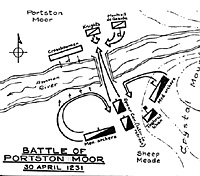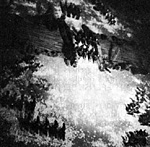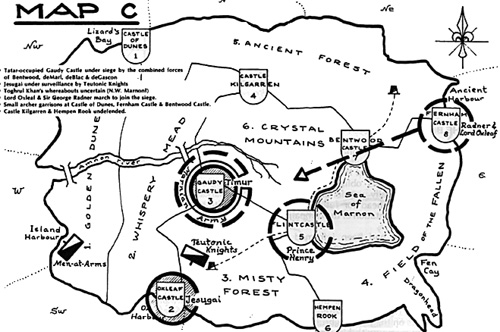Montreil de Gascon's determination to maintain Amnon River as a natural boundary between Tatar occupied lands to the South and the North bank with Castle of Dunes (now in his obligation to defend), and Toghrul Khan's equally unrelenting determination to establish a bridgehead for future expansion, led to the first major confrontation of the campaign.
The Duke of Bentwood had been informed of the Khan's advance northward before he joined the Hospitallers at Marls Gate and was now a day's march from Portston Bridge. De Gascon hoped to hold the bridge until Bentwood could reach them. On the Tatars' approach, in the early evening, the Frankish knights took up their position at the North end of the bridge with crossbowmen on their right flank and de Gascon with the remaining knights on the left. Toghrul Khan halted just out of crossbow range, with his spearmen in the center, flanked on both sides by medium archers. The Franks were outnumbered, but their strength lay in superbly equipped cavalry and the fact that the crossbow outranged the Asiatic composite bow by a meaningful margin. Farthermore, the Tatars were obliged to cross a narrow bridge under fire before closing and chose to wait. Unaware of Bentwood's approach, Toghrul waited too long.
 It was next morning before he made his move with spear cavalry charging across the bridge, while his archers rode at full gallop along the river ank in support, directing a hail of arrows against the crossbowmen and presenting them with a difficult, moving target as they went. The Frankish knights countercharged the Tatar horsemen de Gascon's detachment charging from the flank and inflicting significant losses while losing only 12 of their number.
It was next morning before he made his move with spear cavalry charging across the bridge, while his archers rode at full gallop along the river ank in support, directing a hail of arrows against the crossbowmen and presenting them with a difficult, moving target as they went. The Frankish knights countercharged the Tatar horsemen de Gascon's detachment charging from the flank and inflicting significant losses while losing only 12 of their number.
The crossbowmen fared less well, but stood their ground after 25% losses. Tatar archers from the right flank were to follow the spear cavalry across the bridge, but were forced away by their own retreating spearmen. At this point, Kushala's unit at Gaudy Castle might have been of some help, but on seeing Bentwood's army march past, he decided to remain in the castle instead-probably a wise decision considering the Duke's combined strength.
Toghrul's situation suddenly looked grim. His remarkable successes of the first two weeks, achieved with unbelievable speed, were about to cost him more than he could afford to pay. All the advantages of concentration and mass with which he began were now lost, that advantage reverting to the enemy. The advance northward was ill-prepared and premature-the Khan
realized his mistake.
In a desperate move before the Marnon Army would engage his rear, Toghrul charged across the bridge in full force at the right moment, when the bridge was not blocked by de Gascon's armored knights, and broke through. It was a totally unexpected move, catching the Franks unprepared. Pursuit was out of the question-the heavy horse were no match in speed to Tatar cavalry.
That night, when the Duke of Bentwood arrived, he
found the bridge still in Marnian hands, but Montreil de
Gascon must have strained all his silver-tongued talents
to explain Toghrul Khan's escape from his clutches .
The next several days saw the Marnon Army
preparing to lay siege to Gaudy Castle. Some knights
were sent to keep an eye on Jesugai at Oxleaf and a
small force of Men-at-Arms were on the way to Island
Harbour to seize the Turkish ships there and prevent the
Khan's escape by sea. Toghrul Khan's whereabouts were
uncertain, but presumed to be somewhere in Northwest
Marnon.
The situation stabilized somewhat, while Gaudy
Castle was besieged, at the end of six weeks under the
Tatar onslaught. Major counter-measures, on the part of
Marnon's now mobilized forces, had not yet begun; but all
indications were that it wouldn't be long.
The haphazard mobilization of Marnon, after the
invasion had already begun, was partly responsible for
Toghrul Khan's early successes and cost Oxleaf his
castle. Later, however, Tatar forces moved too fast and
spread themselves too thin. Unaware of Bentwood's
substantial army having been assembled, the Khan
intended to disorient Marnian mobilization efforts even
farther while taking in as much territory as possible. As
time went on, Marnian forces concentrated and deployed
in areas enabling them to maintain constant watch over
the enemy and make their move at the appropriate time.
It seems there is always someone who "didn't get the
word"-refering, of course, to Sir George Radner.
Although his inactivity did not adversely effect the defense
effort, due to the remoteness of Fernham Castle, it stands
as an example of communication problems commonly
encountered by Medieval military commanders. News
were slow to reach even those nearby and were often no
longer news by the time they were received several
leagues away. Distractions, such as the celebration at
Flintcastle, were not uncommon-farther delaying the
communications process.
From the tactical standpoint, the first encounter at
Portston Bridge was no more than a minor skirmish
precipitated by a rush of much stronger infantry unit with
missiles, against a small, light cavalry detachment
without long range weapons and producing predictable
results.
A much more interesting tactical action was the
Battle of Portston Moor. Here, we have the classic
Medieval European force of armored knights with
supporting infantry missile troops against Asiatic light and
medium cavalry variously equipped with long range as well
as melee weapons. The outnumbered defenders had a
definite advantage of position; the river and bridge between
them and the enemy; and made full use of it during the
attack. Although the Tatar shock troops failed to break
through on the bridge-enforced, narrow front, their medium
horse archers carried out a particularly clever and
interesting maneuver. By speeding along the river bank
opposite the Frankish crossbowmen, they were able to
keep them busy and prevent their support of knights the
shock cavalry was attacking. This maneuver surely
minimized their losses while the main attack went in.
Because of the unusual circumstance of 100% elite
troops on both sides, morale played a very minor role in
this battle. All stood their ground and obeyed orders
without faltering-an unlikely occurance in medieval
warfare.
We look forward now to siege operations at Gaudy
Castle-undoubtedly the imminent tactical problem to be
faced by the Franks; and to Toghrul Khan's next
unpredictable move.
Only those works marked with an asterik (*) contain
specific information used to help set up the Marnon
Campaign. Other references listed deal with medieval
times in general, are very informative and help to provide a
"feel" for the period. T. Wise, in his Medieval Warfare,
gives a particularly good, concise explanation of basic
heraldry and Platt's Atlas of Medieval Man is a cornucopia
of events and places. It may be noteworthy that most of
the references were published within the past 8 years-an
indication of currently increasing interest in the medieval
period (?).
*Ian Heath-Armies of Feudal Europe (WRG, 1978) RULES FOR MEDIEVAL MINIATURES
Gygax & Perren-Chainmail (TSR, 1979 3rd ed.)[2] [1] Indicates short, simple rules for beginning players;
This list represents only those medieval rules familiar to author and
certainly not all those available.
Marnon continued... This article appears in MagWeb (Magazine Web) on the Internet World Wide Web. At right, THE BATTLE OF PORTSTON MOOR. DeGascon's
knights are seen charging from the flank (upper right). At lower left are
tatar horse archers just starting their run along the river bank.
At right, THE BATTLE OF PORTSTON MOOR. DeGascon's
knights are seen charging from the flank (upper right). At lower left are
tatar horse archers just starting their run along the river bank.
MARNON DEFENSES AFTER MOBILIZATION AND DEPLOYMENT
(4 weeks after invasion)LOCATION UNIT SIZE TROOP TYPE CLASS DESCRIPTION
COMMANDERS Fernham Castle 260 HI Vet
Pikeman in full armor Sir George Radnor
and Lord OxleafMarls Gate 80 HC Reg Men-at-Arms Sir John DeMarl 140 HC Elite Templars and Teutonic Order Falcon deBlac,
the Earl of Windfor260 HI Vet Hospitaller pikeman Duke of Bentwood Portston Moor 300 MI Elite Crossbowmen Montreil 120 HC Elite Secular Knights de Gascon Castle of Dunes 320 LI Mil Feudal Archers Castle garrison Bentwood Castle 320 LI Mil Feudal Archers Castle garrison
Flintcastle 360 MI Reg Mercenery spearman Sir Henry Total: 2160 (of which 340 are heavy cavalry)  Word of the siege reached Fernham within the week
and Sir George Radner and Lord Oxleaf began their march
to join it, after having received a small feudal archer unit
from Bentwood's garrison to remain in Fernham Castle
while they were away.
Word of the siege reached Fernham within the week
and Sir George Radner and Lord Oxleaf began their march
to join it, after having received a small feudal archer unit
from Bentwood's garrison to remain in Fernham Castle
while they were away.
SHORT ANALYSIS OF THE CAMPAIGN
BIBLIOGRAPHY
*Ian Heath -Armies and Enemies of the Crusades (WRC, 1978)
Terence Wise-Medieval Warfare (Hastings House, 1976)
*Terence Wise- Wars of the Crusades 1096-1291 (Osprey, 1978)
William Urban-The Baltic Crusade (Northern Illinois University Press, 1975)
Charles Knightly-Strongholds of the Realm (Thames & Hudson, 1979)
Colin Platt-The Atlas of Medieval Man (St. Martin's Press, 1980)
S.R. Turnbull-The Mongols (Osprey, Men-at-Arms series, 1980)
Joseph & Frances Gies-Life in a Medieval Castle (T.Y. Crowell, 1974)
Joseph & Frances Gies- Life in a Medieval City (T Y. Crowell 1973)
Jaqueline Fearn-Discovering Heraldry (Gramercy, 1981)
Colin McEvedy-The Penguin Atlas of Medieval History (Penguin, 1979)
Charles Ross-The Wars of the Roses (Thmaes & Hudson, 1976)
E.E. Simbalist-Swords & Sorcerers /re: Steppes Nomads* (FGU, 1978)
Ernle Bradford-The Sword and the Scimitar (Putnam,1974)
Brooks & Walworth-The Worldof Walls (Lippincott, 1966)
ed: Regine Pernoud-The Crusades (Putnam), 1963)
George H. Schneider - Broadsword (Fantasy Games Unlimited, 1977)[2]
Dave Millward-God's Acre ( Heritage Models,1976 3rd ed . )[1]
Terry Ford-Medieval Warfare (Z & M Enterprises, 1977)[1]
Phil Barker- War Games Rules 3000BC-1250AD (WRG 1976 5th ed.)[3]
Phil Barker-War Games Rules 3000BC to 1485AD (WRG 1980 6th ed .)[3]
Boyd & Whitehead-Once Upon A Table . . . (Richard A. Boyd, 1978 2nd ed.)[2]
E.E. Simbalist-Chivalry & Sorcery (Fantasy Games Unlimited)[3]
Christopher Parker- Knighthood & The Middle Ages (Historical Research,1979)[3]
Stephen Lortz-Perilous Encounters (The Chaosium, 1978)[1]
[2] medium complexity with more historical detail;
[3] very detailed, advanced rules.
Back to Table of Contents -- Courier Vol. IV No. 2
Back to Courier List of Issues
Back to Master Magazine List
© Copyright 1982 by The Courier Publishing Company.
Other military history articles and gaming articles are available at http://www.magweb.com